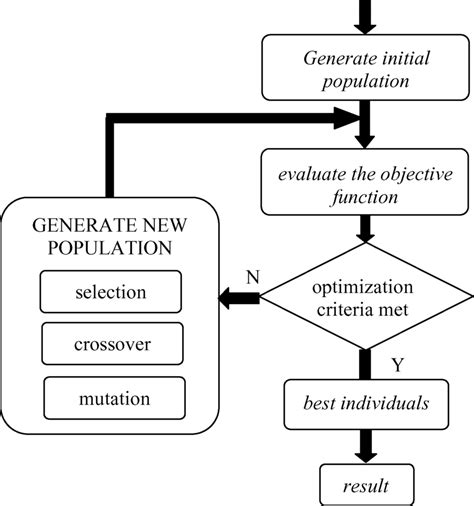Genetic Algorithm Optimization

Welcome to an in-depth exploration of Genetic Algorithm Optimization, a fascinating and powerful technique used in various fields, from engineering to artificial intelligence. Genetic Algorithms (GAs) are a class of evolutionary algorithms inspired by the process of natural selection and genetics. They offer a unique and effective approach to optimization problems, making them a valuable tool in many industries.
In this comprehensive guide, we will delve into the intricacies of Genetic Algorithm Optimization, shedding light on its principles, applications, and potential. By the end of this article, you will have a deep understanding of how GAs work, their real-world impact, and their role in shaping the future of optimization.
Understanding Genetic Algorithm Optimization

Genetic Algorithm Optimization is a computational technique that mimics the process of natural evolution to find optimal solutions to complex problems. It is a powerful tool for solving optimization problems that are either too complex or time-consuming for traditional algorithms.
At its core, a Genetic Algorithm operates by encoding potential solutions to a problem into a format known as chromosomes. These chromosomes are then manipulated using genetic operators, such as mutation, crossover, and selection, to generate new and potentially better solutions. The process continues iteratively, with the fittest solutions surviving and contributing to the next generation, until an optimal solution is found or the algorithm reaches a predefined stopping criterion.
The Role of Chromosomes and Genes
Chromosomes in Genetic Algorithms are analogous to the chromosomes found in biological systems. They are composed of a set of genes, each representing a specific characteristic or parameter of the solution. The genes can take on different values or states, defining the properties of the solution.
For instance, consider a simple optimization problem of finding the best route for a traveling salesman. In this case, a chromosome could represent a specific route, with each gene corresponding to a city on the salesman's journey. The order of the genes within the chromosome defines the sequence of cities to be visited.
Genetic Operators: Mutation, Crossover, and Selection
Genetic Algorithms employ three main genetic operators: mutation, crossover, and selection. These operators work together to drive the optimization process, ensuring that the population of solutions evolves towards better and more optimal solutions.
- Mutation: This operator introduces random changes to individual genes within a chromosome. It helps maintain genetic diversity and can lead to the discovery of new, potentially better solutions. Mutation is often performed with a low probability to prevent excessive disruption of the population.
- Crossover: Crossover involves exchanging genetic material between two parent chromosomes to create new offspring. This operator combines the characteristics of the parents, leading to the exploration of new solution spaces. The crossover rate determines the frequency of this operation, balancing exploration and exploitation.
- Selection: Selection is the process of choosing individuals from the current population to become parents for the next generation. Individuals are selected based on their fitness, which is a measure of how well they perform in solving the given problem. The fittest individuals have a higher chance of being selected, ensuring that the population improves over generations.
Through the iterative application of these genetic operators, Genetic Algorithms explore the solution space, gradually converging towards optimal solutions. The process is inspired by the principles of survival of the fittest and natural selection, where the best solutions survive and propagate, guiding the search towards more successful outcomes.
Applications of Genetic Algorithm Optimization

Genetic Algorithm Optimization has found applications across a wide range of industries and domains, owing to its versatility and effectiveness in solving complex optimization problems. Some notable applications include:
Engineering Design
Genetic Algorithms have proven to be invaluable in engineering design, where they are used to optimize complex systems and structures. For instance, in structural design, GAs can be employed to find the optimal material distribution or topology to achieve desired strength and stiffness while minimizing weight. This application has led to the development of innovative and efficient structures in various industries, including aerospace and automotive.
Machine Learning and Artificial Intelligence
In the field of machine learning, Genetic Algorithms are used for various tasks, including feature selection, hyperparameter tuning, and evolutionary neural network design. GAs can help identify the most relevant features for a machine learning model, optimizing its performance and reducing computational complexity. They are also employed in genetic programming, where they evolve computer programs to solve specific problems.
Scheduling and Planning
Genetic Algorithms excel at solving scheduling and planning problems, making them useful in industries such as manufacturing, transportation, and project management. For example, GAs can optimize production schedules to minimize costs and maximize efficiency, or they can be used to plan delivery routes for logistics companies, taking into account factors like traffic, delivery times, and vehicle capacities.
Financial Modeling and Optimization
Financial institutions and traders use Genetic Algorithms to optimize investment strategies and portfolio allocations. GAs can help identify the optimal combination of assets to achieve desired risk and return profiles, taking into account factors like market trends, historical data, and investor preferences. This application has the potential to revolutionize financial planning and investment management.
Energy Systems and Renewable Energy
Genetic Algorithms are employed in the optimization of energy systems, particularly in the context of renewable energy sources. They can be used to optimize the placement and sizing of wind turbines or solar panels to maximize energy generation while considering factors like wind patterns, solar radiation, and land availability. GAs also play a role in optimizing energy storage systems, helping to balance energy supply and demand.
Biomedical Research and Drug Design
In the biomedical field, Genetic Algorithms are used for drug design and discovery. They can help identify potential drug candidates by optimizing molecular structures to target specific receptors or biological pathways. GAs are also employed in personalized medicine, where they optimize treatment plans based on individual patient characteristics and genetic profiles.
Performance Analysis and Comparison
Genetic Algorithm Optimization has been extensively studied and compared with other optimization techniques. While GAs offer unique advantages, particularly in solving complex, non-linear, and multi-modal problems, they also have certain limitations and considerations.
Advantages of Genetic Algorithms
- Robustness: GAs are robust and can handle a wide range of optimization problems, making them versatile and adaptable.
- Parallelism: Genetic Algorithms can explore multiple solutions simultaneously, taking advantage of parallel processing and distributed computing.
- Global Optima: GAs have a high chance of finding global optima, especially in complex and non-convex search spaces.
- Adaptability: The genetic operators in GAs can be adapted and customized to suit specific problem domains, enhancing their effectiveness.
Limitations and Considerations
- Convergence Speed: GAs may converge slowly, especially in high-dimensional search spaces or with complex fitness landscapes.
- Parameter Tuning: The performance of GAs depends on the careful tuning of parameters such as population size, mutation rate, and crossover rate.
- Local Optima: GAs can sometimes get trapped in local optima, especially if the fitness landscape is deceptive or has many local minima.
- Computational Cost: The computational cost of GAs can be high, especially for problems with large solution spaces or complex fitness functions.
Despite these considerations, Genetic Algorithm Optimization remains a powerful and widely used technique, offering unique insights and solutions to complex optimization problems. Its ability to mimic natural evolution and explore diverse solution spaces makes it a valuable tool for researchers, engineers, and scientists across various disciplines.
Future Implications and Innovations
The field of Genetic Algorithm Optimization continues to evolve and advance, driven by ongoing research and technological innovations. As computational power increases and new algorithms are developed, the potential applications and impact of GAs are expected to grow significantly.
Hybridization and Meta-Heuristics
Researchers are exploring the hybridization of Genetic Algorithms with other optimization techniques, such as simulated annealing, particle swarm optimization, and ant colony optimization. These hybrid approaches aim to combine the strengths of different algorithms, improving their overall performance and efficiency. Meta-heuristic methods, which provide high-level guidelines for optimization, are also being integrated with GAs to enhance their search capabilities.
Machine Learning Integration
The integration of machine learning techniques with Genetic Algorithms is a promising area of research. Machine learning can be used to adaptively tune the parameters of GAs, improving their performance and convergence speed. Additionally, machine learning can help identify and exploit patterns in the search space, guiding the genetic operators towards more promising regions.
Parallel and Distributed Computing
With the increasing availability of parallel and distributed computing resources, Genetic Algorithms are becoming more scalable and efficient. Parallel processing allows GAs to explore multiple solutions simultaneously, reducing the time required to find optimal solutions. Distributed computing, on the other hand, enables the sharing of computational resources across multiple machines, further enhancing the scalability and performance of GAs.
Application in Emerging Technologies
Genetic Algorithm Optimization is expected to play a significant role in emerging technologies, such as quantum computing and artificial intelligence. In quantum computing, GAs can be used to optimize quantum algorithms and circuits, taking advantage of the unique properties of quantum systems. In AI, GAs can contribute to the development of more intelligent and adaptive systems, enhancing their ability to learn and make decisions.
As Genetic Algorithm Optimization continues to evolve and innovate, its impact on various industries and fields is expected to grow. The ability to solve complex optimization problems efficiently and effectively will drive innovation, improve efficiency, and enhance decision-making processes across a wide range of applications.
How do Genetic Algorithms differ from traditional optimization techniques?
+Genetic Algorithms differ from traditional optimization techniques in their approach to finding solutions. While traditional techniques often rely on mathematical models and analytical methods, Genetic Algorithms are inspired by natural evolution and genetics. They explore the solution space through genetic operators like mutation, crossover, and selection, making them particularly effective for complex, non-linear, and multi-modal problems.
What are some challenges in implementing Genetic Algorithm Optimization?
+Implementing Genetic Algorithm Optimization can present several challenges. These include the need for careful parameter tuning, the risk of getting trapped in local optima, and the potential for slow convergence in high-dimensional search spaces. Additionally, the computational cost of GAs can be high, especially for complex problems.
How do Genetic Algorithms contribute to the field of artificial intelligence?
+Genetic Algorithms play a significant role in the field of artificial intelligence, particularly in machine learning and evolutionary computation. They are used for tasks such as feature selection, hyperparameter tuning, and evolutionary neural network design. GAs contribute to the development of more intelligent and adaptive AI systems, enhancing their ability to learn and make decisions.



